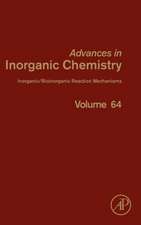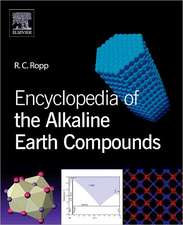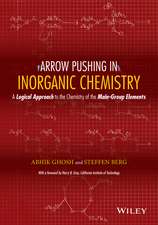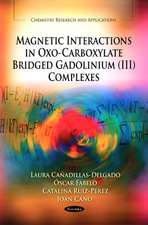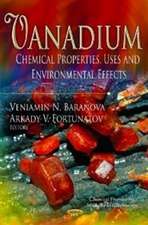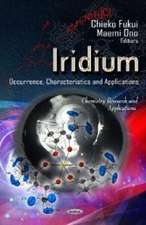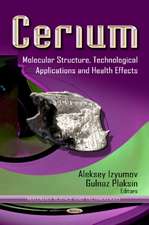The Chemistry of the Actinide and Transactinide Elements (Volume 6)
Editat de Norman M. Edelstein, Jean Fuger, Lester R. Morssen Limba Engleză Paperback – 25 oct 2016
The scope of Volume 6 encompasses: actinides in the geosphere, subsurface interactions of actinides species with microorganisms, chemistry of nuclear fuels, actinide waste forms and radiation effects, analytical chemistry of plutonium, actinide chalcogenide compounds, molecular spectroscopy and reaction of the actinide ions in the gas phase and rare gas matrices, and hydrothermal synthesis of actinide compounds.
This volume is written by active practitioners and recognized experts in their specialty areas. Each of the topics represents the current state of knowledge in this fascinating area of science and technology.
| Toate formatele și edițiile | Preț | Express |
|---|---|---|
| Paperback (1) | 3049.16 lei 6-8 săpt. | |
| SPRINGER NETHERLANDS – 25 oct 2016 | 3049.16 lei 6-8 săpt. | |
| Hardback (1) | 3068.75 lei 6-8 săpt. | |
| SPRINGER NETHERLANDS – 4 oct 2010 | 3068.75 lei 6-8 săpt. |
Preț: 3049.16 lei
Preț vechi: 3718.49 lei
-18% Nou
Puncte Express: 4574
Preț estimativ în valută:
583.45€ • 635.76$ • 491.65£
583.45€ • 635.76$ • 491.65£
Carte tipărită la comandă
Livrare economică 23 aprilie-07 mai
Preluare comenzi: 021 569.72.76
Specificații
ISBN-13: 9789401777315
ISBN-10: 9401777314
Pagini: 1029
Ilustrații: XVII, 1029 p. 76 illus. in color.
Dimensiuni: 155 x 235 mm
Greutate: 1.43 kg
Ediția:Softcover reprint of the original 4th ed. 2011
Editura: SPRINGER NETHERLANDS
Colecția Springer
Locul publicării:Dordrecht, Netherlands
ISBN-10: 9401777314
Pagini: 1029
Ilustrații: XVII, 1029 p. 76 illus. in color.
Dimensiuni: 155 x 235 mm
Greutate: 1.43 kg
Ediția:Softcover reprint of the original 4th ed. 2011
Editura: SPRINGER NETHERLANDS
Colecția Springer
Locul publicării:Dordrecht, Netherlands
Cuprins
Actinide behavior in the geosphere.- Subsurface Interactions of Actinide Species with Microorganisms.- Chemistry of Nuclear Fuels.- Actinide Waste Forms and Radiation Damage.- Analytical Chemistry of Plutonium.- Syntheses and Properties of Actinide Chalcogenides.- High Resolution Spectroscopy and Gas Phase Reactions of Actinide Molecules.- Hydrothermal Syntheses of Actinide Compounds.
Recenzii
The CATE series has been recently completed by a new volume that follows in a continuous way the vision the Editors have for the presentation of actinides in applied and fundamental sciences. In contrast to Volumes 1 to 3 that historically dealt with the series of actinides element per element, Volume 4 and 5 introduced actinides within specific environments, properties or processes. These new Volumes complemented what had been produced in the former Editions of CATE. In this frame, Volume 6 complements also this view with Chapters related to actinides in environment, their analytic and the description of specific properties. If one has to underline key topics on actinide science, specific Chapters may retain attention.
The Chapter Actinides in geosphere combines well which actinides are natural and which are anthropogenic in the environment, tracking them with their isotopic fingerprint. The occurrences of Th and U are well treated and discussed. The presence of the cogenerated 239Np and 239Pu is also discussed together with the primordial 244Pu e.g.[ 1] which remains however a question [ 2]. An assessment shall be valuable (as well as for the claim of Cf). Anthropogenic actinide release from civil activities (reactor or reprocessing accidents) and military (atmospheric, underground tests) activities are well described. Actinide species i.e. defined redox, complexation states and their association/aggregation states (as precipitated, sorbed, mineralized …) affect their retention. These key processes in the migration studies are addressed. These have been the topic of numerous laboratory studies which publications are cited.
However, as pointed out, the number of actinide studies in in-situ tests is astonishingly small. With higher burn-up the need to study actinides must increase. Their potential presence in the environment may become more consequent as well as their associated risks.
The actinide behaviour from nuclear wastes, theefficiency of first barrier and its resistance under irradiation are treated in the Chapter Actinide waste forms and radiation effects. What ever the nuclear fuel cycle strategy, there will be a last cycle or an extension of the cycle with waste as by product. The basis of nuclear waste management implies waste forms with robust actinide containing materials to avoid their release in the geosphere. These are the subject of numerous investigations. These materials are crystalline or non-crystalline. They range from spent fuel to actinide waste glasses, from multiple ceramics waste form to single phase materials such as fluorite pyrochlores, zirconolites, peroskites, specific silicates and phosphates. Predictive models for single phase material behaviour during irradiation as a function of temperature are suggested to describe amorphisation or annealing of the waste form materials as a function of dosis.
The analytical chemistry of plutonium is a key Chapter that combines the sample preparation and the analytical methods: spectrophotometry, emission spectrometry, thermochromatography, volumetry, scanning and transmission electron microscopy and energy dispersive x-ray, including XAS, XRF, and, mass spectrometry including TIMS, ICPMS, AMS and SIMS. The radiometric spectrometry such as a, b, g as well as the neutron detection and the fission track methods are also treated. For more discussion about the detection limits for applying these techniques the reader may refer to Chapter 27 for details. Data handling is included. Important issues of nuclear forensic investigations are illustrated by case studies. The hazards involved with potential nuclear smuggling or terrorism are the driving forces deploying and developing these methodologies.
For actinide fundamental sciences, specific compounds are presented in Chapter 37. The Chapter Actinide chalcogenide compounds needs to be cited. These compounds require to be investigated for example forunderstanding the behaviour and speciation of Se and Te in fuels. The review is systematic; it ranges through binary, ternary and quaternary actinide chalcogenides. Going from AnQ e.g. [ ] to AnQ5 e.g. UTe5 for the binary. Ternary compounds include often an alkali element, while quaternary may include phosphorous. Even if the studies deal mainly with U and Th, a couple of compounds including Pu and P are included in the discussion. The chapter deals mainly with structures of these specific compounds. Thermodynamic data shall be needed in the future to complete the picture.
Finally the Chapter on Hydrothermal synthesis and structures of actinides compounds gives us perspectives. The hydrothermal syntheses were tested for all actinides going from Th through Cf and for redox states ranging from 3+ to 6+. The hydrothermal synthesis method is well suited for the production of macro-crystals. New structures were discovered together with unusual properties such as long range magnetic ordering, selective ion-exchangers, selective oxidation catalysis, photoluminescence and
intercalation for specific actinide compounds. The high quality of
crystals produced allows production of excellent structural data that are well documented in the Chapter.
References
1. Nature 221, 726 - 729 (22 February 1969); doi:10.1038/221726a0, Plutonium-244 in the Early Solar System,
P. K. KURODA, Department of Chemistry, University of Arkansas,
Fayetteville Recent studies on the abundances of 244Pu and 129I in the early solar system support the continuous galactic nucleosynthesis theory. The agreement between the two “nuclear clocks” is excellent.
2. Nature 222, 1156 (21 June 1969); doi:10.1038/2221156a0 Uranium Content of Some Stone Meteorites and their Pu–Xe Decay Interval DAVID E. FISHER Institute of Marine Sciences, University of Miami, Miami, Florida 33149.
Kuroda and Reynolds have recently discussed whether or not thePu–Xe and I–Xe decay intervals of stone meteorites are concordant, and the implications of this question to models of galactic nucleosynthesis. Kuroda states1,2 that they are concordant, while Reynolds3,4 believes the question is still open. Kuroda notes that the 136fXe/U ratios are excessively high in two eucrites, Petersburg and Moore County, indicating Pu–Xe decay intervals for these two meteorites which are not concordant with their I–Xe decay intervals beyond his acceptable limits of error (± 30 per cent). Using his average eucrite uranium abundance of 130 p.p.b. for these two meteorites, instead of their measured abundances of 100 and 40 p.p.b. respectively, he brings the decay intervals to near concordancy, arguing that the measured uranium abundances may well be wrong because of tellurium interferences with the neutron activation analysis. It therefore becomes a critical test of Kuroda's model to measure the uranium in either of these meteorites by a different technique. In particular, the difference between the measured and predicted U abundances in Moore County is significant.
3. Actinide sulfides in the gas phase: experimental and theoretical studies of the thermochemistry of AnS (An = Ac, Th, Pa, U, Np, Pu, Am and Cm) Cláudia C. L. Pereira , Colin J. Marsden , Joaquim Marçalo and John K. Gibson, Phys. Chem. Chem. Phys., 2011, 13, 12940-12958
Review by Prof. Dr. Claude Degueldre, Paul Scherrer Institut, Switzerland.
The Chapter Actinides in geosphere combines well which actinides are natural and which are anthropogenic in the environment, tracking them with their isotopic fingerprint. The occurrences of Th and U are well treated and discussed. The presence of the cogenerated 239Np and 239Pu is also discussed together with the primordial 244Pu e.g.[ 1] which remains however a question [ 2]. An assessment shall be valuable (as well as for the claim of Cf). Anthropogenic actinide release from civil activities (reactor or reprocessing accidents) and military (atmospheric, underground tests) activities are well described. Actinide species i.e. defined redox, complexation states and their association/aggregation states (as precipitated, sorbed, mineralized …) affect their retention. These key processes in the migration studies are addressed. These have been the topic of numerous laboratory studies which publications are cited.
However, as pointed out, the number of actinide studies in in-situ tests is astonishingly small. With higher burn-up the need to study actinides must increase. Their potential presence in the environment may become more consequent as well as their associated risks.
The actinide behaviour from nuclear wastes, theefficiency of first barrier and its resistance under irradiation are treated in the Chapter Actinide waste forms and radiation effects. What ever the nuclear fuel cycle strategy, there will be a last cycle or an extension of the cycle with waste as by product. The basis of nuclear waste management implies waste forms with robust actinide containing materials to avoid their release in the geosphere. These are the subject of numerous investigations. These materials are crystalline or non-crystalline. They range from spent fuel to actinide waste glasses, from multiple ceramics waste form to single phase materials such as fluorite pyrochlores, zirconolites, peroskites, specific silicates and phosphates. Predictive models for single phase material behaviour during irradiation as a function of temperature are suggested to describe amorphisation or annealing of the waste form materials as a function of dosis.
The analytical chemistry of plutonium is a key Chapter that combines the sample preparation and the analytical methods: spectrophotometry, emission spectrometry, thermochromatography, volumetry, scanning and transmission electron microscopy and energy dispersive x-ray, including XAS, XRF, and, mass spectrometry including TIMS, ICPMS, AMS and SIMS. The radiometric spectrometry such as a, b, g as well as the neutron detection and the fission track methods are also treated. For more discussion about the detection limits for applying these techniques the reader may refer to Chapter 27 for details. Data handling is included. Important issues of nuclear forensic investigations are illustrated by case studies. The hazards involved with potential nuclear smuggling or terrorism are the driving forces deploying and developing these methodologies.
For actinide fundamental sciences, specific compounds are presented in Chapter 37. The Chapter Actinide chalcogenide compounds needs to be cited. These compounds require to be investigated for example forunderstanding the behaviour and speciation of Se and Te in fuels. The review is systematic; it ranges through binary, ternary and quaternary actinide chalcogenides. Going from AnQ e.g. [ ] to AnQ5 e.g. UTe5 for the binary. Ternary compounds include often an alkali element, while quaternary may include phosphorous. Even if the studies deal mainly with U and Th, a couple of compounds including Pu and P are included in the discussion. The chapter deals mainly with structures of these specific compounds. Thermodynamic data shall be needed in the future to complete the picture.
Finally the Chapter on Hydrothermal synthesis and structures of actinides compounds gives us perspectives. The hydrothermal syntheses were tested for all actinides going from Th through Cf and for redox states ranging from 3+ to 6+. The hydrothermal synthesis method is well suited for the production of macro-crystals. New structures were discovered together with unusual properties such as long range magnetic ordering, selective ion-exchangers, selective oxidation catalysis, photoluminescence and
intercalation for specific actinide compounds. The high quality of
crystals produced allows production of excellent structural data that are well documented in the Chapter.
References
1. Nature 221, 726 - 729 (22 February 1969); doi:10.1038/221726a0, Plutonium-244 in the Early Solar System,
P. K. KURODA, Department of Chemistry, University of Arkansas,
Fayetteville Recent studies on the abundances of 244Pu and 129I in the early solar system support the continuous galactic nucleosynthesis theory. The agreement between the two “nuclear clocks” is excellent.
2. Nature 222, 1156 (21 June 1969); doi:10.1038/2221156a0 Uranium Content of Some Stone Meteorites and their Pu–Xe Decay Interval DAVID E. FISHER Institute of Marine Sciences, University of Miami, Miami, Florida 33149.
Kuroda and Reynolds have recently discussed whether or not thePu–Xe and I–Xe decay intervals of stone meteorites are concordant, and the implications of this question to models of galactic nucleosynthesis. Kuroda states1,2 that they are concordant, while Reynolds3,4 believes the question is still open. Kuroda notes that the 136fXe/U ratios are excessively high in two eucrites, Petersburg and Moore County, indicating Pu–Xe decay intervals for these two meteorites which are not concordant with their I–Xe decay intervals beyond his acceptable limits of error (± 30 per cent). Using his average eucrite uranium abundance of 130 p.p.b. for these two meteorites, instead of their measured abundances of 100 and 40 p.p.b. respectively, he brings the decay intervals to near concordancy, arguing that the measured uranium abundances may well be wrong because of tellurium interferences with the neutron activation analysis. It therefore becomes a critical test of Kuroda's model to measure the uranium in either of these meteorites by a different technique. In particular, the difference between the measured and predicted U abundances in Moore County is significant.
3. Actinide sulfides in the gas phase: experimental and theoretical studies of the thermochemistry of AnS (An = Ac, Th, Pa, U, Np, Pu, Am and Cm) Cláudia C. L. Pereira , Colin J. Marsden , Joaquim Marçalo and John K. Gibson, Phys. Chem. Chem. Phys., 2011, 13, 12940-12958
Review by Prof. Dr. Claude Degueldre, Paul Scherrer Institut, Switzerland.
Notă biografică
Lester R. Morss is the Program Manager for Heavy Element Chemistry at the Office of Science , U.S. Department of Energy in Germantown, Maryland, USA. He was taught actinide chemistry fbyProfessor Burris B. Cunningham, his Ph.D. mentor at the University of California, Berkeley and from 1971 to 1980 he was a member of the chemistry faculty at Rutgers University, New Brunswick, New Jersey, USA. In 1980, Dr. Morss moved to the Argonne National Laboratory (Illinois, USA), where he remained as an actinide chemist until 2002 . At all of these institutions he carried out research in the inorganic chemistry of lanthanide and actinide elements, with a focus on transuranium elements. His publications were primarily in thermochemistry and structure-bonding relationships among metals, oxides, halides, and coordination complexes. Dr. Morss has had fellowships at the University of Liege, Belgium and at the University of Hannover, Germany (von Humboldt Senior Scientist) and he is also a fellow of the American Association for the Advancement of Science.
Norman Edelstein is an emeritus Senior Scientist at the Lawrence Berkeley National Laboratory (LBNL). He started his studies in actinide chemistry with Professor Burris B. Cunningham in 1964 at LBNL (then the University of California Radiation Laboratory), USA. Following Professor Cunningham’s untimely death in 1972 he became head of the actinide chemistry group and held that position until his assignment in 2000 and 2001 as temporary Program Manager for Heavy Element Chemistry at the Office of Science, U.S. Department of Energy, Germantown, Maryland, USA. His primary research interests are the optical properties, magnetic properties, and electronic structure of the actinides and lanthanides; the general, inorganic and solution chemistry of the actinides; and synchrotron radiation studies of actinides and other environmentally relevant materials. Dr. Edelstein has publishedover 200 papers on these and other topics and has edited three other volumes on actinide subjects.
Jean Fuger is Professor Emeritus at the University of Liège, Belgium, where he has taught courses in radiochemistry, analytical chemistry, and related subjects. In the early stages of his career, whilst associated with the Inter-University Institute for Nuclear Sciences (Brussels, Belgium), he made extensive stays at the University of California Radiation Laboratory, Berkeley, USA, with Professor Burris B. Cunningham, from whom he learned various microchemical techniques in actinide chemistry, with emphasis on preparative chemistry and microcalorimetry. From 1986 to 1997 he served as head of the chemistry division and later as deputy director of the European Institute for Transuranium Elements, Karlsruhe, Germany. His research interests are centered on the structural and thermodynamic properties of the lanthanides and actinides and their compounds, as well as the solution chemistry of these elements. He published about 125 papers, and 20 monographs and book chapters on these topics.
Norman Edelstein is an emeritus Senior Scientist at the Lawrence Berkeley National Laboratory (LBNL). He started his studies in actinide chemistry with Professor Burris B. Cunningham in 1964 at LBNL (then the University of California Radiation Laboratory), USA. Following Professor Cunningham’s untimely death in 1972 he became head of the actinide chemistry group and held that position until his assignment in 2000 and 2001 as temporary Program Manager for Heavy Element Chemistry at the Office of Science, U.S. Department of Energy, Germantown, Maryland, USA. His primary research interests are the optical properties, magnetic properties, and electronic structure of the actinides and lanthanides; the general, inorganic and solution chemistry of the actinides; and synchrotron radiation studies of actinides and other environmentally relevant materials. Dr. Edelstein has publishedover 200 papers on these and other topics and has edited three other volumes on actinide subjects.
Jean Fuger is Professor Emeritus at the University of Liège, Belgium, where he has taught courses in radiochemistry, analytical chemistry, and related subjects. In the early stages of his career, whilst associated with the Inter-University Institute for Nuclear Sciences (Brussels, Belgium), he made extensive stays at the University of California Radiation Laboratory, Berkeley, USA, with Professor Burris B. Cunningham, from whom he learned various microchemical techniques in actinide chemistry, with emphasis on preparative chemistry and microcalorimetry. From 1986 to 1997 he served as head of the chemistry division and later as deputy director of the European Institute for Transuranium Elements, Karlsruhe, Germany. His research interests are centered on the structural and thermodynamic properties of the lanthanides and actinides and their compounds, as well as the solution chemistry of these elements. He published about 125 papers, and 20 monographs and book chapters on these topics.
Textul de pe ultima copertă
This volume is a continuation of the five volumes of The Chemistry of the Actinide and Transactinide Elements that appeared in 2006. Volume 6 expounds on topics in actinide science that are undergoing rapid scientific developments and that are germane to the safe development of nuclear energy in the 21st century, from nuclear fuels to the environmental science and management of waste.
The scope of volume 6 encompasses a wide array of subjects: actinides in the geosphere, subsurface interactions of actinides species with microorganisms, chemistry of nuclear fuels, actinide waste forms and radiation effects, analytical chemistry of plutonium, actinide chalcogenide compounds, molecular spectroscopy and reaction of the actinide ions in the gas phase and rare gas matrices, and hydrothermal synthesis of actinide compounds.
The authors of each chapter are active practitioners and recognized experts in their specialty areas. They have collaborated so as to provide an authoritative, balanced, and comprehensive treatment of their fields. Each of the topics in volume 6 represents the current state of our knowledge in this fascinating area of science and technology.
The scope of volume 6 encompasses a wide array of subjects: actinides in the geosphere, subsurface interactions of actinides species with microorganisms, chemistry of nuclear fuels, actinide waste forms and radiation effects, analytical chemistry of plutonium, actinide chalcogenide compounds, molecular spectroscopy and reaction of the actinide ions in the gas phase and rare gas matrices, and hydrothermal synthesis of actinide compounds.
The authors of each chapter are active practitioners and recognized experts in their specialty areas. They have collaborated so as to provide an authoritative, balanced, and comprehensive treatment of their fields. Each of the topics in volume 6 represents the current state of our knowledge in this fascinating area of science and technology.
Caracteristici
Expounds on topics in Actinide Science that are critical to safe Nuclear Energy development. A valuable addition to the previously published 5-volume set of "The Chemistry of the Actinide and Transactinide Elements"

